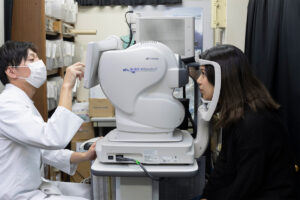Age-related macular degeneration is a disease that causes things to look distorted due to aging and other factors. Symptoms include darkening of vision and decreased eyesight. As the population ages, the number of people suffering from age-related macular degeneration is rapidly increasing. This page explains the causes, symptoms, and treatments of age-related macular degeneration. It also introduces self-check methods and prevention methods.
table of contents
【東京・池袋】加齢黄斑変性の原因・症状・治療方法・費用
What is age-related macular degeneration?

Age-related macular degeneration (AMD) is a disease in which blood and fluid accumulate in the macula, which plays an important role in seeing, causing a decline in vision. As the disease progresses with age, the number of patients is rapidly increasing in our aging society. It is the main cause of acquired blindness, especially in developed countries, and is the fourth leading cause of blindness in Japan.
Types and symptoms of age-related macular degeneration
Symptoms of age-related macular degeneration include:
- The center appears blurry
- It looks distorted
- It's dark and hard to see
- Decreased vision
Symptoms appear in one eye at a time, but because the unaffected eye compensates for the loss of vision, it can be difficult to notice the problem until later.
Age-related macular degeneration is further divided into dry and wet types.
Atrophic type (non-exudative type)
Atrophic type, also known as non-exudative type, is a type in which the cells of the retina gradually become thinner with age. Because the progression is slow, abnormalities may not be noticed until later.
Exudation type
The exudative type is a type of retinal disease in which new blood vessels called "choroidal neovascularization" are formed, which do not normally exist. Choroidal neovascularization is very fragile and prone to bleeding. This bleeding causes swelling in the macula, which reduces vision.
Compared to dry type, it progresses faster and there is a risk of blindness. The risk of blindness is quite low with dry type. However, even if you are diagnosed with dry type, there is a possibility that it may change to exudative type, so be careful.
Image of vision with age-related macular degeneration
When you have age-related macular degeneration, the central part of your vision becomes distorted. Vision outside the central part remains normal. As the condition progresses, symptoms such as "blurry vision" and "dark vision" also appear.
Causes of age-related macular degeneration
Age-related macular degeneration is thought to occur when the ability of the macula and retina to process waste products weakens with age, causing waste products to accumulate and lead to abnormalities. In addition to aging, excessive exposure to ultraviolet rays, smoking, genetic predisposition, and lifestyle habits are also involved.
Flow of Age-Related Macular Degeneration Treatment
Treatment for age-related macular degeneration involves the following steps:
Examination and interview
During the consultation, we will ask about your current eye condition and symptoms, your lifestyle, other illnesses, and medications you are currently taking. We will then decide whether to continue with follow-up or treatment, and which treatment to use.
follow-up
If you are diagnosed with atrophic glaucoma, you may not need to receive treatment right away. In that case, you may need to use eye drops and visit the hospital regularly to monitor your condition.
treat
In cases of exudative type or atrophic type where the condition is progressing, treatment is with anti-VEGF antibody therapy or laser photocoagulation (photocoagulation). After treatment, the patient may be monitored for a while.
Treatment for age-related macular degeneration
There are two treatments for age-related macular degeneration: anti-VEGF antibody therapy and laser photocoagulation (photocoagulation). We will explain the characteristics of each.
Anti-VEGF antibody therapy
It is the only treatment for age-related macular degeneration in Japan that has been shown to improve vision. VEGF is a substance called vascular endothelial growth factor that worsens age-related macular degeneration, and anti-VEGF antibody therapy is a treatment that injects an "anti-VEGF drug" that neutralizes VEGF. Although it requires more than three injections, it is a relatively low-stress treatment because it only takes a few minutes.
Laser photocoagulation (photocoagulation)
Laser photocoagulation is a treatment that stops the progression of the disease by shining a laser beam on the affected area inside the eye and burning it away.
Laser photocoagulation is a treatment that cannot improve vision, but it can prevent the disease from worsening while maintaining your current vision. It is effective not only for age-related macular degeneration, but also for various diseases that occur in the retina.
How to check for age-related macular degeneration yourself
There is a way to check for age-related macular degeneration yourself. Follow the steps below:
- Prepare a grid table such as a notebook.
- Keep the distance between the table and your eyes at about 30cm.
- Cover one eye and look directly at the center of the chart with the other eye.
- Check the appearance in this state
- Look away and rest your eye for a moment, then repeat the same test on the other eye.
*If you normally wear glasses or contact lenses, please wear them as usual while checking.
If you can see straight overall and feel no discomfort, then it is normal. If the image appears distorted in either eye, this may be due to age-related macular degeneration.
How to prevent age-related macular degeneration
Ways to prevent age-related macular degeneration include:
no smoking
It has been shown that smokers are more likely to develop age-related macular degeneration than non-smokers.
十分充分な栄養素を摂る
黄斑部のはたらきをよくするルテインやビタミンC、ビタミンE・亜鉛などが含まれている緑黄色野菜を食べると良いでしょう。また、それらの成分が含まれているサプリメントを摂取するのも1つの手です。
紫外線を防ぐ
紫外線を浴びすぎると網膜に影響を及ぼします。UVカットのサングラスや日傘を使用するなどして、紫外線を浴びないことが大切です。
【東京・池袋】加齢黄斑変性の原因・症状・治療方法・費用の治療に関するよくある質問
加齢黄斑変性の初期症状は?
加齢黄斑変性になると、まずは視界の中心部が歪んで見えます(変視症)。症状が悪化すると、視力が低下する、視界が暗くなるなど他の症状も出てきます。最悪の場合、失明する可能性もあるため、注意が必要です。
加齢黄斑変性で失明するまでの期間はどれくらいですか?
加齢黄斑変性になっても、すぐに失明するわけではありません。特に萎縮性の場合は進行が遅いため、状態を見ながら治療の方針を決めていくことが大切です。
加齢黄斑変性を自分で治すことはできますか?
加齢黄斑変性になると、自力で完治させることはできません。




